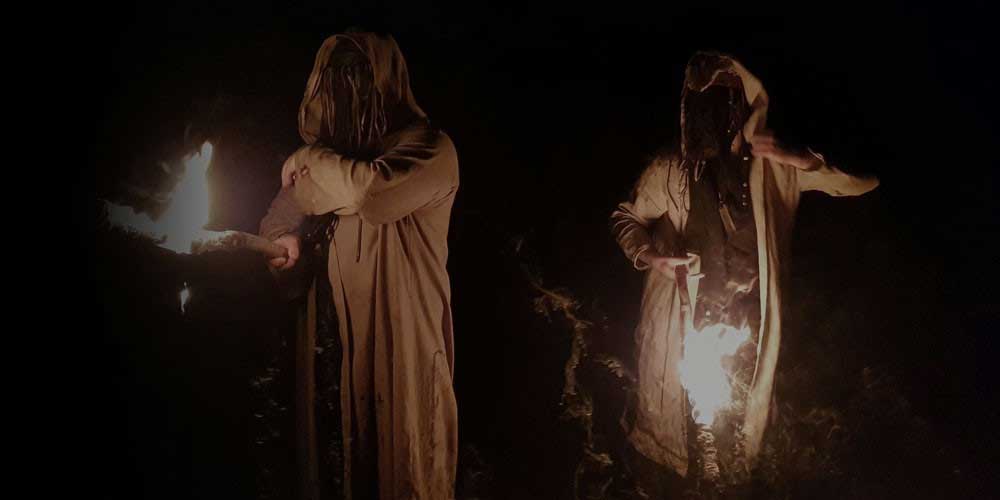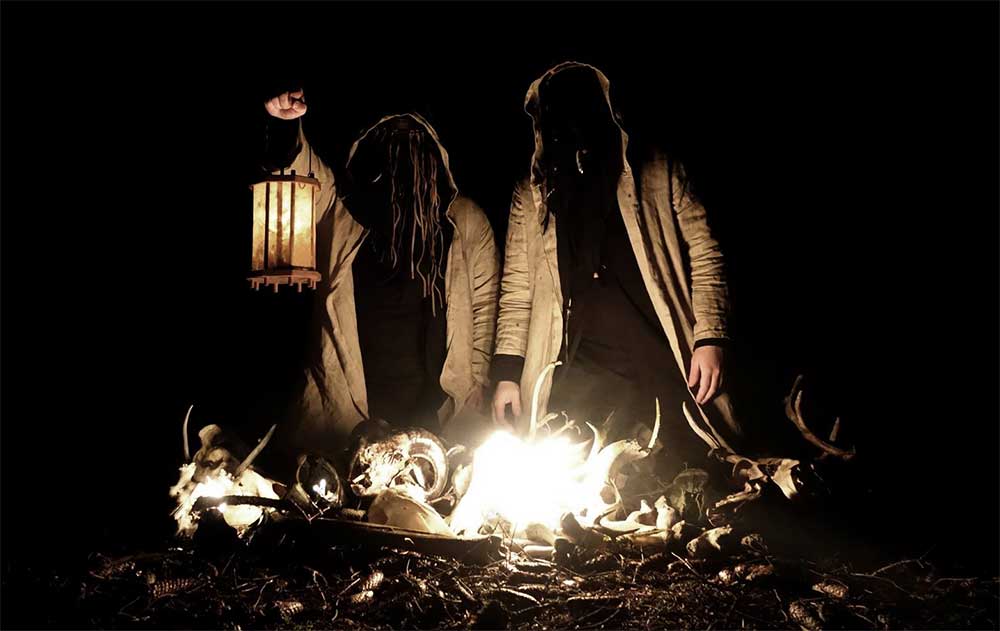Bhleg
2020-12-30
by Niklas Göransson
Tales of destiny from the ancestral sanctuary – a conversation about soil and spirit with S of Swedish black metal duo Bhleg.
– The primary inspiration behind “Ödhin” was the winter season as well as all the associations it has with all living things: death, the predestined fate everything mortal will inevitably face. It’s also an expression of personal experiences related to its destructive power. Winter can be perceived both as breathtakingly beautiful and mercilessly cruel, and this sense of contrast – where things are neither black nor white but left entirely up to individual consideration – has been a recurring concept in BHLEG.
The third studio album of BHLEG is set for release by Nordvis on January 15, 2021. “Ödhin” was composed in its entirety within the timespan of two weeks and then tracked using the band’s own recording setup, Studio Asu. I read that the material emerged through a focus trance of sorts, in the same order as it appears in the track-list.
– That is correct, the only exception being the last song – the one performed only on lyre – which was written at an earlier point. It felt natural to arrange the songs after the torrent they surfaced from. When this tide comes rolling in, it leaves me with the feeling of not being the one in control: it keeps flowing until fully emptied. For this reason, the length of our records is never decided beforehand. For example, “Solarmegin” (2018) is almost one hundred minutes long, whereas “Äril” (2019) is just short of half an hour. This process can be gruelling and tends to leave me completely drained of energy, with a bittersweet sense of emptiness. Whenever we record, each instrument is tracked in a single session. I have always, without exception, recorded all guitars in one and the same day. The same goes for vocals: L tears through all of them in one sitting. Working this way is taxing and can be brutal, quite frankly, but that’s how we’ve always gone about our business.
The lyrics are written in a similar stream-of-consciousness type fashion. Unfortunately, it’s hard to assess their quality since none of them have been published – save for a few short excerpts posted on BHLEG’s social media pages.
– It has nothing to do with quality – L’s lyrics are, in my opinion, fantastic. The primary reason we’ve chosen not to make them available in their entirety is that we don’t want to reveal too much about their meaning. Even though L writes with a mystique that’s often rather subtle, so to speak, we prefer keeping the words confined within the music; meaning, we don’t want to give away any pointers which might influence the listener in what he or she should feel or think. We want everyone to interpret the music and, in a way, allow for it to absorb them in accordance with their own thoughts, emotions, and experiences.

“Ödhin” features a song called “Alyr III”; the first two parts were included on their debut and second album, respectively. The title derives from the area BHLEG call home – a municipality in the Swedish county of Västra Götaland.
– Both of us grew up in the same area, surrounded by the same nature and forests, and that’s a crucial aspect of the “Alyr” series. Alyr is the oldest known name for the region we grew up in, the word itself translates to ‘sanctuary’. That is to say, our forebears referred to these lands as a sanctuary – which I find very telling. Our surroundings are filled with history: I have a Stone Age settlement literally outside the door, there’s an old gallows ground on the summit of a nearby mountain, and further into the woods is a Bronze Age cairn. We also have plenty of rock carvings as well as a runestone in the vicinity. The soil here has been farmed for several millennia up until today. The people have lived and worked from generation to generation, with a constant presence to nature.
Appropriately, the music has a distinctly rural feeling, enhanced by traditional instruments such as hurdy-gurdy, lyre, birch trumpet, as well as different kinds of hand-held drums. None of them are especially adventurous elements in the context of BHLEG’s folk-oriented style, but I must admit that this is the first time I’ve ever heard a rooster on a black metal record.
– There is, of course, a deeper spiritual and mythological connection for why we’ve chosen to include such a sound. Without revealing too much, it’s said that the crowing of a rooster signifies the beginning of the end – the final time before a cycle starts anew. It was my own dear rooster, the late R, who graced the song with a guest performance. Actually, he met his fate earlier this very evening; may his energy forever watch over these lands.
Do you live on a farm of some kind?
– I wouldn’t really call it a farm; however, the property does have an old barn which used to house cattle. These days there are only chickens, cats, and vegetable patches on the premises, but I hope to become more self-sufficient in the future. I moved here when I was twenty, after a few years of aimless drifting. L lives about a three-minute-walk from here, so we see each other regularly. BHLEG as a band – in terms of recording and so on – constitutes only about five percent of our interactions. The rest of our time is spent gathering inspiration in various ways, or just socialising. We are BHLEG every day, in everything we undertake of both mundane and spiritual nature. The rare times we’ve existed as a band has been when rehearsing in preparation for live shows.

BHLEG has been described as a kind of musical manifestation of L and S’ friendship. Having grown up in the same area, they met when both of them were thirteen years old.
– The first time, we hung out for perhaps twenty minutes and quickly realised we had similar musical interests. The second time was a week later when we ended up spending an entire night out in the forest. We even took some band photos – despite not having written a second of music yet, haha. We also discussed our mutual interest for shamanism, folklore, and nature worship. Both of us almost got frostbite on both face and hands, but we were so engulfed by the conversation that we stayed out there way past the time when we were expected home. And this type of situation, where we push ourselves to the max as to not break the flow, has been a permanent fixture of our friendship. All this has had an immeasurable impact; without L, my life would have looked remarkably different. BHLEG would obviously not have existed, and the question is if I had even existed.
One of the primary traits they immediately recognised in one another was their shared passion for spirituality. Perhaps worthy of note here is that Sweden is considered one of the most secular countries in the world, especially among the younger generations.
– The supernatural is something that’s followed both of us from an early age. Ever since childhood, I’ve had a mystical way of relating to the world and have been undergoing ‘paranormal’ experiences as far back as I can recall. These events were so prevalent I took them for granted, as a part of life. But it’s a sad truth, that we’ve lost this closeness here in Sweden. Our ancestors had no choice but to live in constant harmony with these spirits, just to handle everyday life in nature. Such interests aren’t very prevalent among Westerners in general, especially not around the age we were at the time. So, when we found each other and realised we also had this in common, there was an immediate understanding that our bond was something extraordinary. It didn’t feel less special when we discovered that we were born on the same day, the same year.
Have you made any collaborative efforts to reach the so-called spirit world?
– Some together, but mostly separately. Drums are a central tool for me. Breathwork is also important, regardless if it’s about a trance state through intense stimuli like dancing, sex, firewalking, and so on – or low stimuli like meditation or útiseta. I don’t want to comment further on this topic; as a rule, we don’t explain magic. But music in general has a tangible spiritual aspect, a feeling of profundity which can seem far greater than oneself. It’s not physical and can be created from ‘nothing’. Today, we’re so saturated by the constant diluting of everything that was once sacred. The primal current in black metal can, in certain ways, work as a kind of key to the feeling of what once was: a time when art was regarded as something higher, as opposed to mass-produced in a filthy industry.




